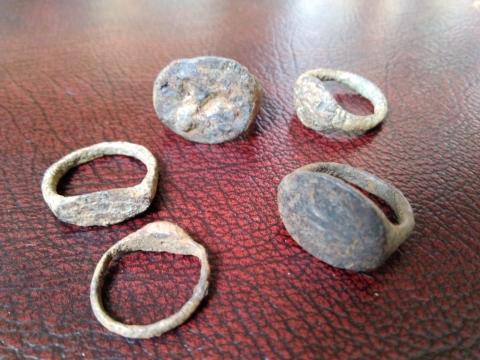Iron Rings

In my cupboards are many strange and unusual items. One of them is a small box containing five iron rings. They date from the first or second century AD and were found by archaeologists in southern England. They are Roman and come in various sizes. There are two explanations for these rings, neither of which is conclusive. Before I describe the two options, let me describe the rings themselves. Significantly, they are made of iron. They are very much rusted, but even when new and freshly made, they would hardly have been attractive. Secondly, some of the rings were made for adult fingers whereas one or two of the others appear to have been made for children.
The first explanation is that they are women's wedding rings. A number of sources for the period describe Roman women as only wearing their gold wedding rings when they left their house and wished to look their best. While going about domestic routines they were more inclined to wear a ring made of iron. This is because there were fewer people to impress, but also because iron is known for its strength, the domestic ring signalling the strength of the marriage even without the flashy adornment seen by the outsider.
The second explanation is that these rings were worn by enslaved persons. To denote their social status or their proprietors’ rights over them, these rings were worn as a public display of ownership. Iron was the material from which most slave shackles and chains were worn and therefore making a ring of the same material would be quite natural. Finger rings, however, could be more easily removed, unlike a manacle or shackle around the wrists, neck or ankle. They may therefore demonstrate that the enslaved persons who wore these rings were more likely trusted by the master, or that they were a sign for others in the neighbourhoods that they were under the protection of a particular person and must therefore be left well alone. We of 21st century sensibility, of course, are likely to find this explanation disquieting, and more inclined to accept the paragraph above. Neither explanation is totally convincing, and there may be more possibilities. For example, they may have been rings worn by the poorest people, who could not afford a precious metal like gold or silver, who made do with that which was common and more readily available. The fact that some of the rings were designed for children, also presents us with the unpleasant prospects of Roman child brides or enslaved kiddies. Our society and culture quite rightly values the child and childhood, which is I think a more fitting reflection of heaven’s own estimation.
Says Job in chapter 7;
“Is there not a time of hard service for man on earth?
Are not his days also like the days of a hired man?
2 Like a servant who [a]earnestly desires the shade,
And like a hired man who eagerly looks for his wages,
3 So I have been allotted months of futility,
And wearisome nights have been appointed to me.
4 When I lie down, I say, ‘When shall I arise,
And the night be ended?’
For I have had my fill of tossing till dawn.
5 My flesh is caked with worms and dust,
My skin is cracked and breaks out afresh.
Whether these rings are symbolic of strong marriages or strong social and economic obligations, we may not be sure. We can be more certain that those people who chose, or were obliged, to wear them are now released from whatever obligations and requirements those rings symbolised. The flesh and bones of those fingers are now gone, and their wearers are now in the afterlife. Death releases us from all earthly mandates and impositions. At the same time, it heralds the appointment we have with the Judge before whom we shall give an account and reckoning of our deeds done in the body. Those who oppressed us, whether within a marriage, a family or an economic arrangement, will be made to realise. For our own deeds we shall also be held accountable. Thankfully, we Christians know that Jesus was held accountable for our sin when He died upon the cross at Golgotha. He who was the Prince of all creation took up the nature of a slave so he might become that most gentle and loving off husbands to Israel, His church. When we forsake the pigsty in sin’s foreign land, and return to His household, He puts a gold ring on our finger and sandals on our feet, though we deserve nothing from Him at all.
- Log in to post comments


 Sunday Worship 10.45am & 6.00pm
Sunday Worship 10.45am & 6.00pm